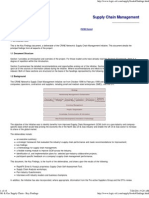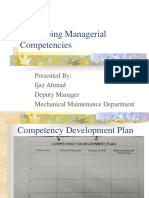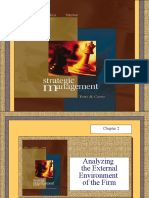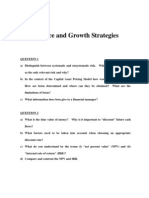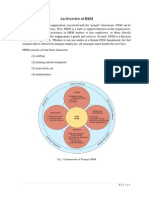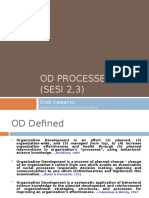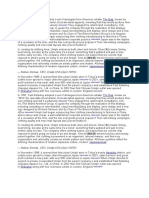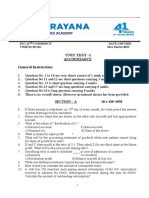HR Specialization Sample Project
Uploaded by
hemant sadafaleHR Specialization Sample Project
Uploaded by
hemant sadafaleEXECUTIVE SUMMARY
The research Project entitled “A STUDY ON EMPLOYEE RECRUITMENT PROCESS
IN SHIV ENTERPRISES” was carried out by me in SHIV ENTERPRISES. The period
of research project was exactly two months from 22nd Oct 2021 to 28th Dec 2021.The
human resources are the most important assets of an organization, the success or failure of an
organization is largely dependent on the people working therein. Without positive and
creative contributions from people, organizations cannot progress and prosper. In order to
achieve the goals or the activities of an organization, therefore, they need to recruit people
with requisite skills, qualifications and experience. Recruitment is the process of attracting
the most suitable people for the position, selection is the process of choosing the best person
for the position, and induction is introducing the person to the position.
OBJECTIVE OF THE STUDY
To understand the recruitment process in Shiv Enterprises.
To study the various sources of recruitment.
To improve the quality of manpower hiring.
Recruiting the right quality of candidate in short period of time.
REASERCH METHODOLOGY
The data analysis for this study was carried out using the quantitative approach. Physical
questionnaire was created and distributed.
Research Area: Shiv Enterprises located in Narayan peth area Pune.
Primary sources: Data was collected from 20 employees using questionnaire method.
Secondary sources: Books and magazines for recruitment definitions, advantages and
limitations.
Sampling technique: Simple random samplings.
Population: 32 employees, out of which the sample size selected was 20 employees due to
constrain of time and cost.
1
SCOPE OF THE STUDY
The scope of this study is to observe the recruitment method adopted by the company. Apart
from getting an idea of the method, a close look was taken over the recruitment process of
the company and necessary findings and changes were suggested accordingly.
LIMITATIONS
Time and cost during the research the researcher was exclusively restricted to 20
employees only because of time constraints and cost constraints. It was slight difficult to
choose only 20 employees out of 32 employees in the company. Time span taken by
research was only for 2 months.
Respondent did not take the questionnaire method seriously.
Respondents were very much reluctant in answering the question
FINDINGS
It seems that maximum number of employees have been working between 0-5 years
The vacancies are declared publicly in the organization during internal recruitment
The job responsibility and job description are clearly defined to the candidates appearing
for the recruitment process
The organization does the proper job analysis before recruitment
The organization gives more preference to the past experience candidate
SUGGESTION
Recruitment must be done by analysing the job firstly which will make it easier and
will be beneficial from the company’s point of view.
More emphasis should be given on internet and advertisement so that more and more
candidates apply for the jobs and it will be easy to find the right employee among
them.
Communication, personal skills need to be tested for employees.
Company should try to use the internet recruitment process first because it incurs less
cost and acts as a motivational factor to the employee.
The recruitment procedure should not be too lengthy and time consuming.
It should also give chance to the freshers for the job.
CONCLUSION:
2
The recruitment process is the backbone of any organisation, The main objective of
conducting the study is to understand the recruitment process and to recruit the right
candidate at the right time for the right place and job. The study has shown that the
Recruitment process carried out in the organisation is direct recruitment process. They
recruit the candidates by the External method, the maximum number of employees
came to know about the job through advertisements, and was seen that the company
made less use of internet as a source of recruitment, As the recruitment was for field
job, due to Covid the candidates preferred more work from home than of field, while
the recruitment process, recruiters focused on the communication, personal skills of
the candidates.
CHAPTER NO. 1
3
INTRODUCTION
1.1 Introduction
The human resources are the most important assets of an organization, the success or failure
of an organization is largely dependent on the people working therein. Without positive and
creative contributions from people, organizations cannot progress and prosper. In order to
achieve the goals or the activities of an organization, therefore, they need to recruit people
with requisite skills, qualifications and experience. While doing so, they have to keep the
present as well as the future requirements of the organization in mind.
Recruitment
Recruitment is distinct from Employment and Selection. Once the required number and kind
of human resources are determined, the management has to find the places where the
required human resources will be available and also find the means of attracting them
towards the organization before selecting suitable candidates for jobs. All the process is
generally known as recruitment. Some people use the term “Recruitment” for employment.
These two are not one and the same. Recruitment is only use of the steps in the entire
employment process. Some others use the recruitment for selection. These are not the same
either. Technically speaking, the function of recruitment precedes the selection function and
it includes only finding, developing the sources of prospective employees and attracting
them to apply for jobs in an organization, whereas the selection is the process of finding out
the most suitable candidate to the job out of the candidates attracted(i.e., recruited). Hiring a
professional by first understanding the exact skill set and then matching it with the various
applicants resumes and then short listing and screening the best fit out of the lot is what is
required. Understanding of all the technology is must and other determining factors like
education background certifications skills and domain type of industry work experience etc
for hiring or recruiting a right professional. Recruitment can be defined as the process of
finding our prospective candidates for filling actual and projected vacancies in an
organisation. Recruitment enables the organization to obtain the types of individual required
for its continuous working. Normally, it is an effort to gain the interest of the candidates
looking for job, find the candidates interest in the job and create a group of potential
employees, with the help of which the management can choose the suitable person for the
job. Recruitment refers to the overall process attracting, shortlisting, selection and appointing
suitable candidates for the job within an organisation. Recruitment can also refer to process
involved in choosing individuals for unpaid roles. Managers, human resource generalist and
recruitment specialists may be tasked with caring out recruitment, but in some cases public
sector employment agencies, commercial recruitment agencies, or specialist search
consultancies are used to undertake parts of the process. Internet based technologies which
supports all the aspects of recruitment have become widespread.
4
Recruitment is the process of attracting the most suitable people for the position, selection is
the process of choosing the best person for the position, and induction is introducing the
person to the position. This module describes a series of well-tested steps to help to identify
the right person, to ensure he or she will fit well with your business, and to meet the various
legal obligations of an employer. If the recruitment is done well, the business benefits from
happier and more productive people, reduced staff turnover, good working relationships and
ultimately a more profitable. The process of recruitment is one the most significant aspect for
operating a business successfully. The quality of the worker determines the performance of
an organisation, and therefore, individuals who efficiently manage all the functions of the
organisation are more suitable for it. By appointing the right person on the right position,
great amount of time, energy and money can be saved. Therefore, it is necessary for manager
to recruit high quality employees in order to fulfil the organisation needs. This module is
about how to approach recruitment, selection and induction of the people in your business. It
is designed for people starting to introduce a more formal business approach, perhaps as
more staff are take on the complexity of the business grows, and for those employees
wishing to improve their current approaches. In human resource management, “recruitment”
is the process of finding and hiring the best and most qualified candidate foe a job opening,
in a timely and cost-effective manner. It can also be defined as the “process of searching for
prospective employees and stimulating and encouraging them to apply for jobs in an
organisation.”When we speak of the recruitment process, we immediately think of activity
such as the analysis of the recruitments of a specific job, attracting candidates to apply for
that job, screening the applicants and selecting among them, hiring the chosen candidates to
become new employees of the organisation, and integrating them into the structure.
Obviously, the main reason why the recruitment process is implemented is to find the person
who are best qualified for the positions within the company, and who will help them towards
attaining organisational goals. Recruitment is done well, the business benefits from happier
and more productive people reduced staff turnover, good. When more persons apply for the
job then there will be a scope for recruiting better person. The job seeker too, on the other
hand, are in search of organisation offering them employment. Recruitment is a linkage
activity bringing together those with jobs and those seeking jobs. The scientific recruitment
process leads to the higher productivity, better wages, high morale, reduction in labour
turnover and enhanced reputation. It stimulates people to apply for jobs; hence it is a positive
process.
Recruitment is concerned with reaching out, and attracting, and ensuring a supply of
qualified personnel and making out selection of requisite manpower both in their quantitative
and qualitative aspect. It is development and maintenance of adequate manpower resources.
This is the first stage of the process of the selection and is completed with the placement.
5
1.2 Statement of The Topic
The statement of the topic is recruitment process at Shiv Enterprises.
In basic idea behind selecting the topic of “Recruitment process” is to study how employees
are hired. Today organisations are coming up with the new techniques and people. Hence to
study how the actual process goes in the organisation.
1.3 Objectives of Recruitment
To understand the recruitment process in Shiv Enterprises.
To study the various sources of recruitment.
To improve the quality of manpower hiring.
Recruiting the right quality of candidate in short period of time.
To assess the importance of recruitment in HRM.
To identify the types of interviews conducted by the company.
1.4 Scope of The Study
Shiv Enterprises located in Narayan Peth, where the study was carried out. The company
supplies manpower to other logistics companies.The total number of employee working in
the company is 32, out of which the sample selected was of size 20.
The scope of this study is to observe the recruitment method adopted by the
company.Apart from getting an idea of the method,a close look wastaken over the
recruitment process of the company and necessary findings and changes were suggested
accordingly.
1.5 Research Methodology Adopted
The data analysis for this study was carried out using the quantitative approach. Physical
questionnaire was created and distributed.
Research Area: Shiv Enterprises located in Narayan peth area Pune.
Primary sources: Data was collected from 20employees using questionnaire method.
Secondary sources: Books and magazines for recruitment definitions, advantages and
limitations.
6
Population: 32 employees, out of which the sample size selected was 20 employees due to
constrain of time and cost.
Sampling technique: Simple random samplings.
1.6 Limitations of Research
Time and cost during the research the researcher was exclusively restricted to 20
employees only because of time constraints and cost constraints. It was slight difficult to
choose only 20 employees out of 32 employees in the company. Time span taken by
research was only for 2 months.
Simple random technique as the word “simple” implies producing a simple random
sample is much less complicated than other methods such as stratified random sampling,
etc. but in the simple random sampling it is difficult to access list of full population. An
accurate statistical measure of large population can only be obtained when a full list of
entire population to be studied as available. Simple random sampling is time consuming,
costly and also it is supposed to be a biased for some instance. Simple random is used for
disadvantaging or limiting factor that employee has been chosen randomly by the
researcher using judgement or those employees who were willing to co-operate to give
the data have been selected for the research study.
Respondent did not take the questionnaire method seriously.
Respondents were very much reluctant in answering the question
7
CHAPTER NO. 2
REVIEW OF LITERATURE
2.1Introduction of Recruitment
The process of finding and hiring the best qualified candidate (from within or outside of an
organisation) for a job opening, in a timely and cost effective manner. This module is about
how to approach recruitment, selection and induction of the people in your business. It is
designed for people starting to introduce a more formal business approach, perhaps as more
staff are taken on and the complexity of the farm business grows, and for those employers
wishing to improve their current approaches. Recruitment is the process of attracting the
most suitable people for the position, selection is the process of choosing the best person for
the position, and induction is introducing the person to the position. This module describes a
series of well-tested steps to help you to identify the right person, to ensure he or she will fit
well with and to meet the various legal obligations of an employer. If recruitment is done
well, the business benefits from happier and more productive people and reduced staff
turnover.
The process of recruitment is one of the most significant aspect for operating a business
successfully. The quality of the workers determines the performance of an organisation, and
therefore, individuals who efficiently manage all the functions of the organisation are more
suitable for it. Even though, changes can be bought in some incompetent employees by
training rigorous supervision, recruitment of capable and passionate people is undoubtedly
preferred. By appointing the right person on the right position, great amount of time, energy
and money can be saved. Therefore, it is necessary for a manger to recruit high quality
employees in order to fulfill the organisation needs. This module is about how to approach
recruitment, selection, and induction of the people in your business. Recruitment is a linkage
activity bringing together those with jobs and those seeking jobs. In simple words, the term
recruitment refers to discovering the sources from where potential employees may be
selected. The scientific recruitment process leads to the higher productivity, better wages,
high morale, reduction on labour turnover and enhanced reputation. It stimulates people to
apply for jobs, hence it is positive process.
8
2.2Definitions of the term Recruitment
1.According to Keith Davis, “Recruitment is the process of finding and attracting capable
applicants for employment. The process begins when new recruits are sought and ends when
their applicants are submitted.”
2. According to Edwin B. Flippo, “Recruitment is the process of searching for prospective
employees and stimulating them to apply for jobs in the organisation.”
3.According to Mart and T. Telsang, “Recruitment is the generating of applications or
applicants for a specific position.”
4. According to Prof. R. W. Griffin, “Recruitment is the process of attracting individuals to
apply for jobs that are open.”
5. According to Decenzo and S.P. Robbins, “Recruitment is the process discovering the
potential for actual or anticipated organisational vacancies.”
2.3 Importance of Recruitment
Fig no.2.1
9
1. Determines present and future recruitment:It involves identifying and preparing
potential job applicants for higher position. It is significant for every organisation to
find out the existing and future needs of the organisation as per the human resources
planning and job analysis activities.
2. Creates and increases the application pool:Recruitment develops a pool of talent
candidates to facilitate the selection of the most suitable candidates for the
organisation. It helps to gather an appropriate number of acceptable applicants for
each job position at the minimum cost. It has been observed that the worth of
selection to an organisation rises with the increases the pool of potential candidates.
Infact, a larger group of qualified applicants indicates that there are more suitable
applicants available for the vacant job position.
3. Increases success rate of selection: By lowering the percentage of the applicants
who are either less qualified or who have undesired knowledge, skills and ability for
recruiting organisation, recruitment increases the success rate of selection process.
Staff time, material and physical facilities are needed by tis kind of processing. If the
recruitment programme brings the applicant which do not match the requirement of
the vacant job position, the result can be terrible.
4. Meets organisational obligations:the objectives of recruitment isto meet the
organisational legal and social obligations concerning the demographic composition
of its judged by the demographic features of those recruited and selected.
5. Increases and evaluates effectiveness: The present as well as the future
effectiveness of the individual and the organisation gets increased due to recruitment.
It also assesses the effectiveness of a variety of recruiting methods and sources for all
types of job applicants.
6. Reduces turnover: Once recruited and selected, the recruitment process minimise the
chances that job applicants will quit the organisation in the initial phase of placement.
This in turn result in retention of potential employees.
7. To align human talent with the company’s goals: Through strategic recruitment,
companies can make sure they have the right set of skills to support the business both
now and in the future. Recruitment is not just about putting bodies in chairs. Its about
identifying the skills, expertise and leadership that the business needs to grow and
outperform the competition.
8. To recruit efficiently: Efficiently does not always mean at the lowest cost, but
obviously, a business will not want to spend more on recruitment and hiring than it
has to. Efficient recruiting means placing the right job advertisement in the right place
to attract the right candidates at the right time.
9. To ensure legal compliance: human resources management is a minefield of laws
and regulations that aim to support workers and stop employers from abusing their
10
power. Anti-discrimination laws and equal opportunity employment are just two of
them.
10. Possess pervasive function: Recruitment is a pervasive function as all organisation
engage in recruiting activity. But the volume and the nature of recruitment varies with
the size, nature and the environment of the particular organisation.
2.4 Methods of recruitment
Fig no.2.2
Despite the fiercely competitive nature of recruiting, many employers still use traditional
recruitment sources, at least initially. Some of these are reactive in nature. Various
traditional methods of recruitment are as follows:
1. Transfer & Promotions: This is a method of filling vacancies from within through
transfers and promotions.
A transfer is an internal movement within the same grade, from one job to another. It
may lead to changes in duties & responsibilities, working conditions, etc., but not
necessarily salary.
11
Promotion on the other hand, involves movement of employee from a lower level
position to a higher level position accompanied by changes in duties, responsibilities,
status and value.
2. Advertisements: The ads generally give a brief outline of the job responsibilities,
compensation package, prospects in the organisation, etc. This method is appropriate
when the organisation intends to reach a large target group and wants a fairly good
number of talented people who are geographically spread out.
3. Radio & Television: Radio and television are used to reach certain types of job
applicants such as skilled workers. Radio and television are used but sparingly, and
that too, by government departments only. Companies in the private sector are
hesitant to use the media because of high costs and also because they fear that such
advertising will make the companies look desperate and damage their conservative
image.
4. Job posting:Job posting is an internal method of recruitment in which notices of
available jobs are posted in central locations throughout the organisation and
employees are given a specified length of time to apply for the available jobs.
5. Scouting: This is one of the oldest methods. In this method the personnel department
sends their representatives to potential candidates seeking employment. Preliminary
screening/ interviews are arranged at selected places wherein the candidates present
themselves. In these effort local/consultants agents/institutions/colleges play the
liaison work. Organising conventions, indoctrination seminars, fairs, etc., are other
means in this method.
6. Schools, colleges and professional institutions: They offer opportunities for
recruiting their students. These general and technical/professional institutions provide
blue-collar applicants, white-collar and managerial personnel.
7. Recruitment at the factory gate: It is a method of direct recruitment by placing a
notice at the factory gate, specifying the details of the jobs available.
8. Unconsolidated application: For positions in which large numbers of candidates are
not available from other sources, the companies may gain in keeping files of
applications received from candidates who make direct enquiries about possible
vacancies on their own, or may send unconsolidated applications.
9. Voluntary organisations: Voluntary organisations such as private clubs, social
organisations, might also provide employees- handicaps, widowed or married women,
old persons, retired hands, etc., in response to advertisements.
10.Previous applicants: Although not entirely an internal source, those who have
previously applied for jobs can be re-contacted by mail, a quick and inexpensive way
to fill an unexpected opening. Applicants who have just “walked in” and applied may
be considered also. These previous walk-ins are likely to be more suitable for filling
unskilled and semi-skilled jobs; but some professional openings can be filled by
turning to such applicants. One firm that needed two cost accountants immediately
12
contacted qualified previous applicants and was able to hire two individuals who were
disenchanted with their current jobs at other companies.
Modern or scientific recruitment methods are a new-age solution designed to
overcome problems in traditional recruitment methods like demand prediction, and
critical skill-set supply. This method is used when there is no or less output by traditional
methods. Modern sources of recruitment are the sources that can be used at a limited
work atmosphere.
1. Electronic recruiting: It is also known as e-recruiting/web-based/internet
recruitment. It makes use of technology to assist the recruitment process. It is one of
the fastest-growing recruitment methods. Internet recruiting can be extremely
effective in generating applicants due to its low cost, speed, and ability to target
applicants with technical skills.
2. Social media: Most young professionals use Facebook and twitter more commonly
than they read the newspaper. Facebook and twitter are used for everything from
news to family updates. Even sports recruiters have used Facebook and twitter for
scouting. Companies can maximise the benefit of social media and other e-recruiting
strategies by ensuring that they engage with customers, employees, and job
candidates through these channels.
3. Smart phones: Smart phones access to countless applications and virtually any web
page. Job candidates all over the world are glued to their phones. Companies interact
in their space by optimising their career portals, providing ample information about
the company online, and even leveraging older phone features like SMS for
recruiting.
4. Air display: It includes new methods of display of vacancy in the organisation
through air balloons or banners display by airplanes.
5. Stickers: Most companies use stickers for display of vacancy. Generally there is the
post name and the phone number of the company. These are stuck on cars and walls.
6. Kiosks: Kiosks are seen at malls, airports, or in large stores. Kiosks can contain
marketing and branding message and engage user with voice, video and interactive
exercise such as aptitude test. It looks like a video game. They can collect candidate
information and integrate with the talent pools
7. Cultural or Social events: Nowadays there is a great participation of companies in
the social and cultural events. In the event there is a stall of the particular company
which has the brochures containing information about the job and profile.
8. Conversion of clients as employees: Most of the companies have opted this
technique of recruitment. Now the companies give job offers to their respective
clients and ask them to be an employee of their firm. Regular customers generally
have the knowledge of product chain of the company.
13
9. Billboard advertising: It is usually limited to an enlarged logo with company name,
a statement about employment advantage, and available jobs and a phone number. It
helps in providing a limited amount of information so that the average driver can
easily understand and retain the information provided. For example, hotel, restaurants,
airlines.
10.Glow sign boards: Many companies use glow sign board for displaying jobs and
vacancies. Glow sign board can be easily viewed at night also while driving.
2.5 Sources of Recruitment
When a person is needed to fill a vacant organisational position, the individual may come
from inside or outside the organisation. Some organisations prefer to recruit from within,
since this helps in enhancing employee morale, loyalty and motivation. Other organisations
prefer to recruit externally to prevent in-breeding and encourage new ways of thinking.
Although recruitment policy varies from organisation to organisation, there are two sources
of recruitment: (1) Internal and (2) External.
Sources of recruitment
Internal sources External sources
Size of organisation Media advertising
Recruitment policy Recommendations by present
Image of organisation employees for their friends &
Image of job relatives
Costs Government employment agencies
Existing employees
Private employment agencies
Former employees
Employee referrals On-campus recruiting
Labour unions
Casual applicants
Leasing
Head-hunting
Data Banks
14
Fig no. 2.3
Internal recruitment carries a number of advantages for the employer. There will be obvious
benefits in appointing, particularly to senior posts, those who already have detailed
knowledge of procedure and structures and whose personal contacts may prove invaluable.
Such appointments can cultivate and enhance the moral of the employees of the organisation
since it encourages executives in lower ranks to look forward to rising to higher levels. It
promotes loyalty among the employees by giving them a sense of job security and
opportunities of personal growth and advancement.
However, internal recruitment has certain which include the following:
If often to inbreeding and the organisation may stagnate without “new blood”.
The internal candidate may not be the best in the market.
Internal sources may tend to “dry up” and it may be difficult to find the necessary
manpower from within the organisation especially when expansion is taking place
rapidly creating numerous vacancies.
Internal promotions may cause friction amongst existing staff – If promotion is
made automatic, or based only on seniority, complacency sets in and standards
deteriorate.
Likes and dislikes of management may play an important role in the selection of
personnel.
The factors that can be regulated by the organisation itself are called the internal factors.
These are various factors in the organisation which influenced the recruitment programmer.
i. Size of the Organisation:The size of an organisation affects the recruitment process.
Experience suggests that larger organisations find recruitment less problematic than
organisations with smaller in size.
ii. Recruitment policy:The recruiting policy of the organisation i.e., recruiting from
internal sources (from own employees) and from external sources (from outside the
organisation) also affects recruitment process. Generally, recruiting through internal
sourcing is preferred, because own employees know the organisation and they can
well fit into the organisation’s culture.
iii. Image of the organisation:Image of organisation is another internal factor having its
influence on the recruitment process of the organisation. Good image of the
organisation earned by a number of overt and covert actions by management helps
attract potential and competent candidates.
iv. Image of the job:Just as image of organisation affects recruitment so does the image
of a job also. Better remuneration and working conditions are considered the
characteristics of good image of a job.
15
v. Costs: Recruitment expenses are borne by the employer, therefore, organisation try to
make use of that sources of recruitment which gives more output in less cost.
vi. Existing employees: The most common source of internal recruitment is through
existing employees. Organisations normally maintain inventories of qualifications to
choose employees performance, educational background and suitability. The usual
method of creating a pool of internal applicants is through job postings.
vii. Former employees: Former employees are also considered as an internal source of
recruitment for they are acquainted with the policies and practices of the organisation.
Besides, they enjoy familiarity with the present employees in most cases. It is now
increasingly common to take back employees who left the firm for various reasons.
viii. Employees referrals: This method refers to the practice of the present employees
providing information about the candidates who are willing to be considered for the
present vacancies. The applicants may be the friends or relatives of the referring
employees. Referral is also a cost-effective source of recruitment.
1. External sources:
Organisations usually go to external sources for lower-entry level jobs; for positions whose
specifications cannot be met by present personnel; for diversifying into new avenue; and for
merging with another organisation. Among the external sources, following are included:
i. Media advertising: Today all forms of media advertising are used in recruiting
employees. Most typical are newspapers, trade and professional journals, radio and
television. This can have the advantage of reaching very large numbers of potential
candidates as well as more specialised audience but can also be costly.
ii. Recommendations by present employees for their friends and relatives:
Introductions by existing staff can be fruitful source since they are likely to
recommend somebody who will live up to their recommendations. However, the
candidates should be carefully screened as others.
iii. Government employment agencies: Employment exchanges are regarded as good
source of recruitment for unskilled, skilled, or semi-skilled jobs. The job seekers get
their names registered with employment exchanges managed and operated by the
central and state governments.
iv. Private employment agencies:In the technical and professional areas private
agencies are providing great services. They maintain files of both individuals
interested in employment and organisations seeking new personnel. They provide a
variety of vocational interest and aptitude testing in order to better understand the
candidates ability to perform in a particular line of employment.
v. On-campus recruiting: Schools, Colleges, Universities and Technical institutions
are very useful source of recruitment for a full range of jobs. Recruitment from
16
education institutes long been a well-established practice of many public and private
organisations. Campus recruiting in an expensive operation.
vi. Labour unions: Labour unions also serve the recruiting needs of the individual and
the organisation. Their sense of co-operation helps in developing better labour
relations. In some of the skilled jobs, the vacancies are filled through the union
placement service. This saves recruitment costs.
vii. Casual applicants: “Kindly consider me for a suitable vacancy in your organisation”
type of letters is a common occurrence in most of the organisations. Such unsolicited
applicants, both through the mail and at the gate, constitute a much-used source of
personnel.
viii. Leasing:To adjust to short-term fluctuations in personnel needs, leasing of personnel
is done for some specified period. This practice is particularly well-developed in the
office administration field. The avoids any obligation in pensions, insurance, and
other fringe benefits.
There are all kinds of variations and two or more methods can of course be used
simultaneously. The advantages and disadvantages of external recruitment are basically the
converse of those we have discussed in respect of internal recruitment. The major
disadvantages is usually mentioned to be the “braindrain” problem when experienced people
are “raided” or “hunted” by concerns.
2.6Advantages of Recruitment
17
Fig no. 2.4
1. Improves employee moral and productivity: When employees know that they can
apply for positions and take control of their career advancement, it automatically
improves productivity fuelled by a desire to perform better on the current jobs. This
motivates them and boosts employee morale.
2. Carries low risk:Companies that prefer recruiting internally understand that the risk
within internal hires is lesser compared with ones recruited externally. They have
detailed records of employee performance reviews, compensation, recognition or
awards, along with peer and manager reviews that are reliable predictors of
performance.
3. Cheaper than external recruitment: It is common knowledge that hiring is an
expensive activity. This includes external costs such as agency and recruiter fees, and
internal expenses like recruiter salaries and the money spent on the referral program.
When companies hire from within, they skip all the external costs and most of the
internal costs.
4. Quicker results: Internal hired employees tend to assimilate and deliver results
faster. They are either nominated by the hiring manager or might know someone from
the team, which helps them get comfortable with the team faster. F
18
5. Increased chances: In this increased chance, the company receives a variety and
number of candidates who owns knowledge and ability to handle that job. If the
company enters a selection procedure with an external recruitment, then there are
increased chances of finding a suitable candidate for a job.
6. Competitive Advantage :Skilled employees influence your organization’s ability to
innovate effectively. The recruiting process can help you find an ideal candidates who
could be the keystones in the success of your business.
7. Qualified candidates: Nowadays, when a company posts an advertisement in the
social media or newspaper. One common thing they look for is a well experienced
and qualified candidate. With external recruitment advertising, the company can find
a variety of qualified candidates for the post offered. And eventually, this process
helps to identify the best candidates in a lot pf skilled candidates.
8. Fresher skill and input:When an company goes with an externalrecruitment method,
there is a quite better possibility of finding and identifying a fresher candidate who is
capable of delivering new skills and inputs for the betterment of the company.
9. Generation of creative ideas: Most probably when the company is in need of those
candidates who can provide creative ideas for the growth of the company, then the
company needs to go with an external recruitment process for overall development of
the company.
10.Lesser internal politics: In the external recruitment process, there is a very less
possibility that the candidate might face internal politics of existing candidates. And
these lesser internal politics avoids a number of internal issues and requests of the
existing employees of the company. Once the candidate is selected, then the company
can be aware of all the political and internal disputes of the company as well.
2.7 Limitations of Recruitment
19
Fig no.2.5
1. Process consumes a lot of time: Recruitment is a lengthy process, and the
recruitment agency take a lot of time to find the correct candidates. A recruitment
team isn’t helpful when you want a candidate to fill a vacant position immediately.
Hence, recruitment is a very time consuming.
2. Communication gap: The only way to communicate with the recruitment team is via
emails or telephones. There can be times where the team doesn’t properly understand
what the company wants and finds a wrong candidate. On the other hand, the
company’s HR department is always there so, they can proactively search according
the company’s need. They understand the business model in a better way as well.
3. Internal policies of the organisation: The policy of filling job vacancies through
internal sources can restrict the organisation to select the talented candidates from the
external sources.
4. Not practical for temporary hires: Hiring a recruitment team for finding candidates
for project work isn’t ideal since the person is only going to work for a limited time.
So, you will only have to bear the load of finding employees on a temporary basis.
5. Image of the organisation: Sometimes the appropriate candidates may not be willing
to apply for the job because of the negative image of the organisation in their mind.
20
6. Fraud recruitment ads: Sometimes the individuals may fall prey to online scams
when applying and giving personal information to the people who are not genuinely
trying to recruit. These hackers may perform data and identify theft.
7. Negative comments from rejected candidates: After receiving too many job
applications on social media, it is natural to reject a large number of individuals who
do not fulfill the requirements as per the job. Some of the individual may get angry,
spread a negative image of the company amongst their friends and may post negative
comments about the company on different websites.
8. Unattractive job: The image of the organisation may be good, but if the concerned
job itself is not attractive, it would not attract suitable and qualified candidates.
9. Budgetary support: Recruitment of candidates from outside requires money.
Sometimes, because of limited budget available, the organisations may not carry out
the recruiting efforts for longer periods of time. This may constrain the HR managers
efforts to attract the best person for the job.
10.Government interference: Government can interfere in the working of organisations
particularly in the government, (central & state) local bodies and quasi-government
organisations. For example, reservation for special groups has to be observed while
recruiting the candidates for jobs regardless of the fact that more qualified and
suitable candidates are available.
2.8 Process of Recruitment
Recruitment is a process consisting of various activities, through which search of prospective
personnel- both in quality- as indicated by human resource planning and job description and
job specification is made. Recruitment process is a process of identifying the job vacancy,
analysing the job requirements, reviewing applications, screening, shortlisting and selecting
the right candidate. It sources the candidates with the abilities and attitude, which are
required for achieving the objectives of an organisation.
21
Fig no.2.6
1. Recruitment planning: Recruitment process starts with its planning which involves
the determination of following:
i. Number of contacts:Organisations, generally, plan to attract more applicants than
what they intend to select as they wish to have option in selecting the right
candidates. The option is required because some of the candidates may not be
interested in joining the organisation; some of them may not meet the criteria of
selection. Therefore, each time a recruitment programme is contemplated, the
organisation has to plan about the number of applications it should receive in order
to fulfil all its vacancies with right personnel.
ii. Type of contacts: This refers to the type of personnel to be informed about the job
openings based on job description and job specification. The type of people
depends on the tasks and responsibilities involved and the qualifications and
experience expected.
2. Identifying recruitment sources: After the finalisation of recruitment plan indicating
the number and type of prospective candidates, they must be attracted to offer
themselves for consideration to their employment. This necessitates the identification
of sources from which these candidates can be attracted.
3. Contacting sources: After the finalisation of sources from where the prospective
candidates will be selected, the process of contacting these sources starts. Recruitment
is a two-way street; it involves recruiter and recruitee. A recruiter has the choice of
whom to recruit, based on the information about the candidates.
22
4. Application pool:Whatever the method of recruitment is adopted, the ultimate
objective is to attract as many candidates as possible so as to have flexibility in
selection. When the sources of recruitment are contracted, the organisation receives
applications from prospective candidates.
5. Selection process: Selection is the process of differentiating between applicants in
order to identify those with a greater likelihood of sources in a job. In selection
process, only personnel with specific skills like expertise in using selection tests,
conducting interviews, etc, are involved.
6. Evaluation and Control: Evaluation and control is essential to improve the efficiency
of future recruitment efforts. It should be borne in mind that recruitment is a costly
process that includes costs such as the recruiters salary, advertising costs, managers
salaries and other direct and indirect costs. It is therefore essential that the recruitment
process should be evaluated.
23
CHAPTER-3
COMPANY PROFILE
3.1: Name:
Shiv enterprises
3.1 Introduction:
We are one of the trusted organizations, engaged in offering labour contracting services as
per the needs and demands of the clients. For carrying out different job works, we provide
labours on contract basis as per the defined industry standards. Further, we make sure that
the labours provided by us are well versed in their respective domain and have complete
knowledge of handling the machines & equipment. Keeping in mind the budgetary
constraints of our clients, we offer our labour contractor at market leading prices.
The company was founded by MR. Narendra Gaikwad in year 2010, Since last 12 years we
provide sufficient and necessary qualified staff to our clients. We are equipped with latest
computerized system to serve customer effectively & quickly and maintaining the records.
Domestic industries require a skilled workforce, which is the foundation of their success.
The flexibility and convenience are prerequisites for competitive world today. Businesses
are in need of diversified workforce as per evolving requirements. Shiv enterprises provides
junior level talent across various sectors in Maharashtra. We strive to connect right
workforce with the right business globally.
Our vision
Our Vision is inspired with a mission to create Leaders, Winners and Achievers in a Global
Competitive World. To be globally recognized as Reputed Professional Manpower
Consulting Firm for Corporate, Individuals and Entrepreneurs.
Our mission
We are committed to support our esteemed client's requirements by delivering on time,
building trustworthy relationships and by offering complete recruitment and training
solutions.
24
3.2 Our products and services:
Temporary Staffing
Permanent Staffing
Contract Staffing
Contract to Hire
Recruitment Process Outsourcing (RPO)
Payroll Services
3.3 Our clients:
Blue dart
Aramex courier
Busybees logistics
25
Flipkart
Amazon
Bewakoof.com
26
3.4 Organisational structure
Fig 3.1 Organizational Structure
27
CHAPTER 4
RESEARCH METHODOLOGY
OBJECTIVE OF THE STUDY
RESEARCH DESIGN
To understand the To study the To improve the Recruiting the
recruitment various sources of quality of right quality of
process in Shiv recruitment. manpower hiring. candidate in short
Enterprises. period of time.
Primary Primary
Primary
Data Data
Data
Interviews Interviews
Interviews
Observation Observation
Observation
Questionnaire Questionnaire
Questionnaire
Secondary Secondary
Data Data
Books Books
Websites Websites
Organize
Analysis
Findings
28
Conclusion
Suggestion
Fig: 4.1
DATA COLLECTION
The data collection process can be relatively simple depending on the type of data collection
tools required and used during the research. Data collection tools are instruments used to
collect information for performance assessments, self-
evaluations, and external evaluations. The data collection tools need to be strong enough to
support what the evaluations find during research. For the project primary data collected
from distribution channel like distributors, dealers and Retailers and secondary data from
books.
PRIMARY DATA:-
Primary data is the specific information collected by the person who is doing the research. It
can be obtained through questionnaire method, case studies, true experiments and
randomized controlled studies. During this research the primary data is collected through
direct survey or questionnaire method.
SECONDARY DATA:-
Secondary data is the research which is based on gathering the information from the
findings of other researchers. There are two sources of secondary data including
external or internal research. Secondary data is the data collected processed and
published by someone else either for his personal use or for public use. This data is not
originally collected by the researcher but obtained from published or unpublished
sources
29
30
CHAPTER 5
DATA ANALYSIS AND INTERPRETATION
31
Question 1: identify the source from where you came to know about the job.
Parameter Number of respondent Percentage
Advertisement 10 50%
consultancy 0 0%
Personal reference 5 23%
Campus recruitment 0 0%
E-recruitment 6 27%
Fig 5.1: Percentage of people came to know about the job
INTERPRETATION: According to 50% of employees came to know about the job through
advertisement and 27% people came to know about the job through E-recruitment and
23% people came to know about the job through personal reference.
32
Question 2:Are you satisfied with the recruitment process by which you are selected?
Parameter Number of respondent Percentage
Yes 17 87%
No 3 13%
Fig 5.2 Percentage of employee’s satisfaction of recruitment process
INTERPRETATION: According to 87% employees where satisfied with their recruitment
process and 13% employees were dissatisfied
33
Question 3: What are the sources for recruitment and selection?
Parameter Number of respondent Percentage
Internal 7 36%
External 13 64%
Fig 5.3: percentage of employee who preferred source of recruitment
INTERPRETATION: According to 64% of employees liked external recruitment and 36%
employees disliked the internal recruitment.
34
Question 4: How was the approach of management during the recruitment?
Parameter Number of respondent Percentage
Serious and Positive 4 20%
Casual 14 70%
Negative 2 10%
Fig 5.4: Percentage of approach of management
INTERPRETATION: According to 70% of employee’s managements approach was casual
during the recruitment and 20% thinks that they have serious and positive approach and
10% said management have negative approach
35
Question 5: What impression/ image you were having of the shiv enterprises before getting recruited?
Parameter Number of respondent Percentage
Satisfactory 11 55%
Average 9 45%
Fig 5.5 Percentage of image of the firm before getting recruited
INTERPRETATION: According to 55% of employees were satisfactory about the image of
firm and 45% had average image of the organization
Question 6: Since how many years you have been working with the organization?
36
Parameter Number of respondent Percentage
0-5 12 60%
5-7 4 20%
7-12 4 20%
Fig 5.6: percentage of years’ people working in the organization
INTERPRETATION: According to 60% of employees working in the organization since last 5
yearsand 20% of employees are working since 5 to 7 years and 20% of employees are
working in the organization since last 7 to 12 years
Question 7: How do you rate the recruitment policy of the organization?
37
Parameter Number of respondent Percentage
Good 6 30%
Average 10 50%
Poor 4 20%
Fig 5.7 percentage of rate of recruitment policy
INTERPRETATION: according to 50% of employees rate the average rate of the organization
policy of the organization and 30% employees rated good and 20% employees rates the
organization policy as poor recruitment policy of the organization
38
Question 8: Do you think organisation looks for experienced employees in recruitment
Process?
Parameter Number of respondent Percentage
Yes 12 60%
No 10 40%
Fig 5.8: Percentage of organization prefer experience employee
INTERPRETATION: According to 60% of employee the organization looks for experienced
employee during the recruitment process and 40% employees thinks organization does not
look for experienced employee
Question 9: Which is the most important quality the organization looks for in a candidate?
39
Parameter Number of respondent Percentage
Knowledge 5 25%
Past Experience 8 40%
Discipline 7 35%
Fig 5.9: Percentage of candidates quality
INTERPRETATION: According to 40% of employees the organization looks for past
experience quality of candidate during the recruitment and 35% of employees thinks
organization looks for discipline candidates and 25% employees thinks the organization
looks for quality of knowledge.
Question 10: Do you think organization is using satisfactory methods of interview ?
40
Parameter Number of respondent Percentage
Yes 16 80%
No 4 20%
Fig 5.10: percentage of satisfactory method of interview
INTERPRETATION: According to 80% of employees were satisfied from interview method
and 20% employees were not satisfied from interview method
Question 11: Do you think organization prefer referred candidates?
41
Parameter Number of respondent Percentage
Yes 19 5%
No 1 95%
Fig 5.11 Percentage of referred candidate
INTERPRETATION:According to 95% employees the organization do not prefer referred
candidates, but there are 5% employees who thinks the organization prefer the referred
candidates
Question 12: Does the recruitment method used by organization are reliable?
42
Parameter Number of respondent Percentage
Yes 9 45%
No 11 55%
Fig 5.12: reliability of recruitment process
INTERPRETATION: It is shown that the recruitment method used by the organization is
reliable for half of the employees. Hence according to 45% employee’s recruitment method
used by the organization is reliable and 55% do not find it reliable.
Question 13: Does the recruitment process brings the correct employee for the organization?
43
Parameter Number of respondent Percentage
Yes 16 80%
No 4 20%
Fig 5.13 Percentage of correct employees
INTERPRETATION: According to 80% of employees the recruitment process brings the
correct candidate in the organization and 20% employees then it as the recruitment process
does not bring the correct employees in the organization
Question 14: For internal recruitment are the vacancies declared publicly?
Parameter Number of respondent Percentages
44
Yes 20 100%
No 0 0%
Fig 5.14: Declaration of internal recruitment
INTERPRETATION: According to 100% of employee’s deceleration of the internal
recruitment are done publicly
Question 15: How do you rate the recruitment process of the organization?
Parameter Number of respondent Percentage
45
Good 15 75%
Average 5 25%
Poor 0 0%
Fig 5.15 Percentage of recruitment process rate
INTERPRETATION: According to 75% employees rates the recruitment as good and 25%
employees gave average rate to the recruitment process
Question 16: Does the organization do proper job analysis before recruiting?
Parameter Number of respondent Percentage
Yes 20 100%
46
No 0 0%
Fig 5.16: Percentage of job analysis
INTERPRETATION: It is shown that the organization is doing proper job analysis before the
recruitment process begins. Hence, 100% employees think that the organization is doing
proper job analysis
Question 17: Is the resume screening and shortlisting method used by the
organization Is satisfactory?
47
Parameter Number of respondent Percentage
Yes 17 85%
No 4 15%
Fig 5.17: Percentages resume screening and shortlisting method
INTERPRETATION: According to the 85% of employees were satisfied by the method of
resume screening and shortlisting and 15% were not satisfied
Question 18: Which method should be used for recruitment?
48
Parameter Number of respondent Percentage
Structured 9 45%
Unstructured 7 35%
Problem question 4 20%
Fig 5.18: Percentage of which recruitment method should me used
INTERPRETATION: According to 46% of employees structured method should be used for
the recruitment and 34% thinks unstructured method and 20% thinks that the problem
questions should be used during the recruitment
Question 19: Does the Job Responsibilities and Job Description are clearly defined to the
candidates appearing for recruitment process?
49
Parameter Number of respondent Percentage
Agreed 17 85%
Disagree 3 15%
Fig 5.19: Percentage of job responsibility and job description
INTERPRETATION: According to 87% of employees were agreed that the job responsibilities
and job description are clearly defined to the candidate appearing for selection
Question 20: Does HR provide an adequate pool of quality applicants?
50
Parameter Number of respondent Percentage
Yes 16 80%
No 4 20%
Fir 5.20: Percentage of quality applicant
INTERPRETATION: According to 80% employees the HR provides an adequate pool of
quality applicant and 20% were disagree
CHAPTER 6: FINDINGS
51
It seems maximum number of employees came to know about the job through the
advertisement.
Almost more than half employee are satisfied with the recruitment process from which
they were selected
The approach of the management is casual toward the candidate during the recruitment
process.
The image of the company was satisfactory to the candidates before getting recruited.
It seems that maximum number of employees have been working between 0-5 years
The maximum employees think the organization looks for experienced employees
during the recruitment
The organization gives more preference to the past experience candidate
The organization is using satisfactory method during interview and employees are
satisfied with the method
The organization does not prefer the referred candidate
The recruitment process brings the correct employee in the organization
The vacancies are declared publicly in the organization during internal recruitment
Maximum employees are satisfied by the recruitment process
The organization does the proper job analysis before recruitment
The employees are satisfied by the resume screening and shortlisting method used by
the organization
The structured method should be used for recruitment
The job responsibility and job description are clearly defined to the candidates
appearing for the recruitment process
The HR provides adequate pool of quality applicant
7: LEARNINGS OF STUDENT:
52
1. A pool of candidates appeared through various sources, which became difficult to
screen and forward the candidates profile ahead due to less recruitment team.
2. Due to pandemic candidates preferred less field jobs and more of work from
home/office jobs.
3. Due to communication gap between internal team there was a delay in the process of
recruitment and shortlisting the candidates which lead to time consumption and delay
in sharing the profile ahead to the clients.
4. During the pandemic, as most of the people preferred online shopping there was a
requirement of bulk hiring from the clients which the company wasn’t ready to
complete it in the short notice.
5. The screening of employees had to be done more specifically as it was for external
purpose.
6. Internet was used less as a source of recruitment.
7. The company mostly preferred experienced candidates.
8:CONTRIBUTION TO HOST ORGANISATION:
53
From the findings I can suggest Shiv Enterprises Pune branch following things for the more
effectiveness of recruitment:
Recruitment must be done by analysing the job firstly which will make it easier and
will be beneficial from the company’s point of view.
More emphasis should be given on internet and advertisement so that more and more
candidates apply for the jobs and it will be easy to find the right employee among
them.
The recruitment procedure should not be too lengthy and time consuming.
Company should try to use the internet recruitment process first because it incurs less
cost and acts as a motivational factor to the employee.
Manpower recruitment of each department in the comply is identified well in advance.
It should also give chance to the fresher’s for the job.
The organisation must also look after the past experience and optimistic nature of the
employee.
Communication, personal skills; need to be tested for employees.
9: CONCLUSION:
54
The recruitment process is the backbone of any organisation, The main objective of
conducting the study is to understand the recruitment process andto recruit the right
candidate at the right time for the right place and job. The study has shown that the
Recruitment process carried out in the organisation is direct recruitment process. They
recruit the candidates by the External method, the maximum number of employees
came to knowabout the job through advertisements, and was seen that the company
made less use of internet as a source of recruitment, As the recruitment was for field
job, due to Covid the candidates preferred more work from home than of field, while
the recruitment process, recruiters focused on the communication, personal skills of
the candidates.
55
Bibliography/ Wibibliography
https://www.tutorialspoint.com/recruitment_and_selection/recruitment_process.htm
https://www.jobsoid.com/recruitment-process/
https://energyresourcing.com/blog/7-advantages-using-recruitment-agency/
https://www.thebalancecareers.com/recruitment-and-hiring-process-2062875
https://recruiteze.com/infographic-the-benefits-and-limitations-of-a-dedicated-
recruitment-team/
ANEXTURE
56
PROJECT QUESTIONNAIRE FOR RECRUITMENT PROCESS
STUDENT NAME: RIYA BISEN
ROLL NO:20_12
NAME OF THE COLLEGE: Shivaji Maratha institute of management and research
SHIV ENTERPRISES
NAME OF THE EMPLOYEE:
DEPARTMENT:
DESIGNATION:
DATE:
PLACE:
SIGNATURE
Q1: identify the source from where you came to know about the job.
a. Advertisement
b. Consultancy
c. Personal reference
d. Campus recruitment
e. E- Recruitment
Q 2: Are you satisfied with the recruitment process by which you are selected?
a. Yes
b. No
57
Q 3: What are the sources for recruitment and selection?
a. Internal
b. External
Q 4: How was the approach of management during the recruitment?
a. Serious and positive
b. Casual
c. Negative
Q 5: What impression/ image you were having of the shiv enterprises before getting
recruited?
a. Satisfactory
b. Average
Q 6: Since how many years you have been working with the organization?
a. 0-5
b. 5-7
c. 7-12
Q 7: How do you rate the recruitment policy of the organization?
a. Good
b. Average
c. Poor
Q 8: Do you think organisation looks for experienced employees in recruitment Process?
a. Yes
b. No
Q 9: Which is the most important quality the organization looks for in a candidate?
a. Knowledge
b. Past experience
c. Discipline
Q 10: Do you think organization is using satisfactory methods of interview?
58
a. Yes
b. No
Q 11: Do you think organization prefer referred candidates?
a. Yes
b. No
Q 12: Does the recruitment method used by organization are reliable?
a. Yes
b. No
Q 13: Does the recruitment process brings the correct employee for the organization?
a. Yes
b. No
Q 14: For internal recruitment are the vacancies declared publicly?
a. Yes
b. No
Q 15: How do you rate the recruitment process of the organization?
a. Good
b. Average
c. Poor
Q 16: Does the organization do proper job analysis before recruiting?
a. Yes
b. No
Q 17: Is the resume screening and shortlisting method used by the organization Is
satisfactory?
a. Yes
b. No
Q 18: Which method should be used for recruitment?
59
a. Structured
b. Unstructured
c. Problem question
Q 19: Does the Job Responsibilities and Job Description are clearly defined to the
candidates appearing for selection process?
a. Agreed
b. Disagree
Q 20: Does HR provide an adequate pool of quality applicants?
a. Yes
b. No
Thank you for your cooperation and time!!
60
61
You might also like
- Nbf-Stock Calendar Event-2024-09-23t20 28 46-04 00100% (1)Nbf-Stock Calendar Event-2024-09-23t20 28 46-04 0022 pages
- Project-On-Recruitment-And-Selection-Process-1 (20 Files Merged)100% (1)Project-On-Recruitment-And-Selection-Process-1 (20 Files Merged)20 pages
- Petroleum (Crude Oil) As An Energy SourceNo ratings yetPetroleum (Crude Oil) As An Energy Source25 pages
- A Study On Recruitment and Selection Process Organization With The Help of Recruiting AgencyNo ratings yetA Study On Recruitment and Selection Process Organization With The Help of Recruiting Agency10 pages
- Business Development Plan of Turnkey Projects For Startup Mep FirmNo ratings yetBusiness Development Plan of Turnkey Projects For Startup Mep Firm12 pages
- (Project) Environmental Justice Approach Through Compensation, Remediation, and Mitigation in The Context of Petroleum Pollution ImpactsNo ratings yet(Project) Environmental Justice Approach Through Compensation, Remediation, and Mitigation in The Context of Petroleum Pollution Impacts83 pages
- Strategic Management Plan: (A Strategic Pathfinder For Petroleum Company)No ratings yetStrategic Management Plan: (A Strategic Pathfinder For Petroleum Company)39 pages
- Articulate Ebook Reskilling and Resilience100% (1)Articulate Ebook Reskilling and Resilience34 pages
- Building Innovation Into The Outsourcing Relationship: A Case Study0% (1)Building Innovation Into The Outsourcing Relationship: A Case Study6 pages
- A Project Report: Training and Development in "Oil and Natural Gas Corporation Limited"No ratings yetA Project Report: Training and Development in "Oil and Natural Gas Corporation Limited"73 pages
- What You Should Know Before Buying A Gas TurbineNo ratings yetWhat You Should Know Before Buying A Gas Turbine6 pages
- A Focused Review of Literature On FMCG Marketing in Rural and Urban MarketsNo ratings yetA Focused Review of Literature On FMCG Marketing in Rural and Urban Markets13 pages
- Demand Forecasting: Presented By:-Ruchika Dangi100% (1)Demand Forecasting: Presented By:-Ruchika Dangi26 pages
- The Role of Maintenance in Improving Company Competitiveness and ProfitabilityNo ratings yetThe Role of Maintenance in Improving Company Competitiveness and Profitability17 pages
- BA7036-Strategic Human Resource Management and DevelopmentNo ratings yetBA7036-Strategic Human Resource Management and Development5 pages
- Organisational Change Management A Criti PDF100% (1)Organisational Change Management A Criti PDF12 pages
- Strategic Management : Gregory G. Dess and G. T. LumpkinNo ratings yetStrategic Management : Gregory G. Dess and G. T. Lumpkin16 pages
- Process Operator or Operator Technician or Refinery OperatorNo ratings yetProcess Operator or Operator Technician or Refinery Operator2 pages
- BBPP1203 Principles of Management For Non-Business Majors - Caug17 (Bookmark) .OutputNo ratings yetBBPP1203 Principles of Management For Non-Business Majors - Caug17 (Bookmark) .Output148 pages
- The Chemical Engineer - Get Chartered Guide 2017 - June 2015 PDFNo ratings yetThe Chemical Engineer - Get Chartered Guide 2017 - June 2015 PDF24 pages
- Oman's Oil & GAS Industry: Presented byNo ratings yetOman's Oil & GAS Industry: Presented by25 pages
- Lessons Learned From Implementing Best Practices in Risk Based Process SafetyNo ratings yetLessons Learned From Implementing Best Practices in Risk Based Process Safety12 pages
- The Value Analysis Program: A How-to-Guide for Physician Leaders On Starting Up a Successful ProgramFrom EverandThe Value Analysis Program: A How-to-Guide for Physician Leaders On Starting Up a Successful ProgramNo ratings yet
- WARN 8572 Aimbridge Employee Service Corp. AKA Valley River InnNo ratings yetWARN 8572 Aimbridge Employee Service Corp. AKA Valley River Inn2 pages
- PT Pyridam Farma TBK: Dan Entitas Anak/And SubsidiariesNo ratings yetPT Pyridam Farma TBK: Dan Entitas Anak/And Subsidiaries72 pages
- Batch Specific UoM and Active Ingredient ManagementNo ratings yetBatch Specific UoM and Active Ingredient Management31 pages
- S34653 DMS Exchange Agreement - Aero Mongolia AirlinesNo ratings yetS34653 DMS Exchange Agreement - Aero Mongolia Airlines4 pages
- Xii Commerce Unit Test-1 Exam Accountancy Q.paper Dt.2021No ratings yetXii Commerce Unit Test-1 Exam Accountancy Q.paper Dt.20216 pages
- David Jaison - Digital Marketing Resume ExampleNo ratings yetDavid Jaison - Digital Marketing Resume Example1 page
- Final Project Report of Job Description (Updated)100% (1)Final Project Report of Job Description (Updated)70 pages
- Investment in Equity Securities - Problem 16-5 and 16-7No ratings yetInvestment in Equity Securities - Problem 16-5 and 16-74 pages
- Analysis of Tesla's Marketing Strategy in ChinaNo ratings yetAnalysis of Tesla's Marketing Strategy in China9 pages
- Your Google Shopping Ads are about to be boostedNo ratings yetYour Google Shopping Ads are about to be boosted9 pages

































